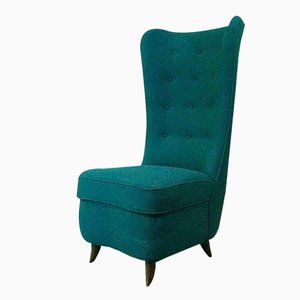
Italian architect-designer Paolo Buffa (1903-1970) was active between the 1930s and 1960s. He is known for an array of furniture designs that marry Neoclassical and Art Deco motifs with modernist principles. His pieces rarely include identifying marks, making them difficult to authenticate.
Born and raised in Milan, Buffa studied architecture at the city’s famous Politecnico, graduating in 1927. The following year, he established a design studio with Antonio Cassi Ramelli, whom he had met during a brief stint working in the atelier of Gio Ponti and Emilio Lancia. Together they made their professional debut with a dining room installation at the 1930 Triennale. Sometime between the 1933 and 1936 Triennales, Buffa opened his own studio.
Designing for the Milanese upper classes in the 1930s, Buffa’s designs were expertly handmade in fine materials, resulting in a quality that of rivaled French Art Deco legend Emile-Jacques Ruhlmann. In collaboration with talented ébénistes—like Mario Quarti—and specialized craftsmen, Buffa was able to slowly introduce modernized, streamlined techniques in the early 1940s, which allowed the designer to increase his output. The evolution of Buffa’s increasingly modern aesthetic is clear, from early Neoclassical cabinets with intricate ornamentation and opulent inlays, to '60s-era, pared down lounge chairs and consoles. In the 1960s, the designer collaborated with large-scale Italian manufacturer Cassina.
In addition to furniture design, Buffa presided over many architectural and interior design projects, which ranged from the design of tombs—his first commission—and a yacht for Egyptian royalty, to villas, hotels, opera houses, and offices.
Despite Buffa’s prolificity and his significant contribution to the development of midcentury Italian design culture, relatively little has been written about the designer since his death in 1970. Nevertheless, the appetite for Buffa designs on the vintage market is growing. Design enthusiasts and collectors alike value Buffa’s designs as much for their high-quality craftsmanship and materials as for their classic aesthetic and association with the foundation of the modernist movement in Italy.

